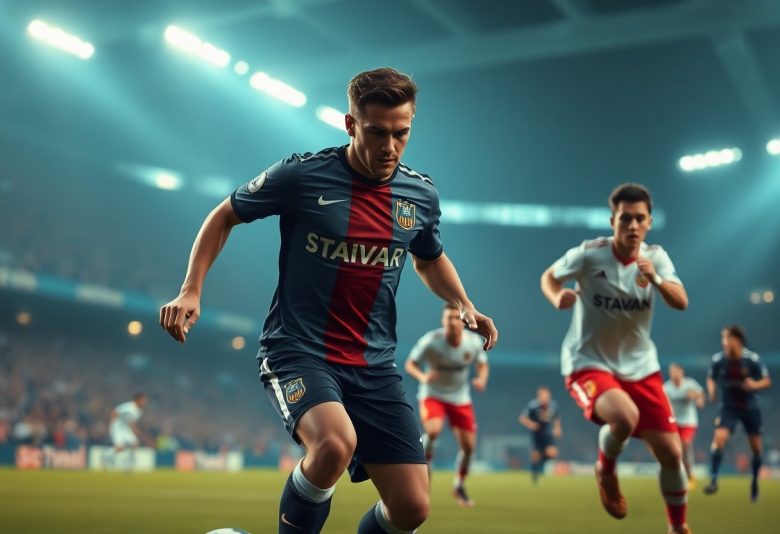Many football enthusiasts have noticed a significant evolution in the game’s midfield dynamics. As pressing becomes a fundamental tactic employed by teams worldwide, the role of the press-resistant midfielder has emerged as crucial to maintaining possession and dictating play. You may find yourself curious about what sets these players apart and how they can effectively evade defenders while enhancing your team’s attacking options. This post examines into the characteristics, skills, and growing importance of these unique midfielders, helping you better understand their pivotal contributions on the pitch.
The Evolution of the Midfielder
While the role of the midfielder has changed dramatically over the decades, the core responsibilities of controlling the game’s tempo and providing support to both the defense and attack remain constant. You can appreciate how the evolution of tactical formations and player conditioning has transformed midfielders into central figures who dictate play and contribute significantly to both offensive strategy and defensive solidarity.
Historical Role of Midfielders
Before the modern game, midfielders primarily functioned as link players, often focusing on distribution while maintaining a presence in defense. Your understanding of this role enhances when you consider how early midfielders were often tasked with simple passes and positioning without the now-familiar responsibilities of high pressing or goal scoring.
Changes in Tactical Approaches
Changes in football tactics have redefined the convoluted role of midfielders, evolving them into dynamic athletes capable of fulfilling multiple functions. Instead of just linking defense and attack, you now see midfielders orchestrating play, pressing opponents, and even contributing to the scoring sheet.
Plus, as teams adopt more fluid systems like possession-based football and high pressing, your perception of the midfielder’s effectiveness expands. They now need to read the game instinctively, adapt to changing situations, and demonstrate tactical versatility. This shift has led to the emergence of press-resistant midfielders, who operate effectively under pressure, making them indispensable in today’s game.
Characteristics of a Press-Resistant Midfielder
It is necessary for today’s midfielders to possess characteristics that enable them to thrive under pressure. A press-resistant midfielder demonstrates the ability to maintain composure while making quick decisions, showcasing an advanced understanding of the game. This type of player not only has exceptional ball control and awareness but also utilizes their body effectively to shield the ball from opponents. As the game evolves, recognizing these key traits will help you identify the press-resistant talents making a significant impact on the pitch.
Technical Skills
Above all, technical skills are foundational for a press-resistant midfielder. You need to excel in ball control, dribbling, and passing accuracy to outmaneuver defenders. A refined first touch allows you to manage tight situations, while quick decision-making enables you to find the best passing options, helping your team maintain possession and build attacking plays under pressure.
Physical Attributes
One of the most important physical attributes for a press-resistant midfielder is agility. You should possess nimble footwork and quick reflexes to navigate through crowded areas effectively. Moreover, a solid balance and core strength will allow you to withstand challenges from opponents while maintaining control of the ball.
For instance, possessing good lower body strength not only helps you remain upright during tackles but also allows you to shield the ball effectively. Additionally, excellent stamina ensures that you can consistently perform at a high level, easily transitioning between defensive duties and attacking support. Being fit enhances your ability to cover ground quickly, making you a constant threat and an adaptable player in various game scenarios.
Influential Players in the Modern Game
One of the most significant developments in modern football is the emergence of press-resistant midfielders who have the unique ability to dictate play in tight situations. These players showcase exceptional ball control and vision, allowing them to navigate through defensive pressure while maintaining possession. Their influence extends beyond individual skill; they can reshape the tactical approach of any team, making them indispensable assets in today’s game.
Profiles of Key Press-Resistant Midfielders
Game changers such as Kevin De Bruyne, Marco Verratti, and Frenkie de Jong exemplify the qualities of press-resistant midfielders. Each has mastered the art of evading defenders and creating opportunities through precise passing and intelligent movement. Their ability to remain calm under pressure allows your team to transition seamlessly from defense to attack, making them pivotal to your squad’s success.
Impact on Team Dynamics
At the heart of modern football, press-resistant midfielders significantly influence team dynamics. Their presence allows for greater ball retention and enhances a team’s attacking fluidity. You will find that these players can create spaces for forwards while alleviating pressure from the backline, effectively transforming defensive situations into offensive opportunities.
Dynamics shift markedly when you have a press-resistant midfielder in your lineup. Having such a player enables your team to execute tactical plays more efficiently, allowing for deeper involvement from wingers and strikers. You will notice improved communication and movement as players become more confident in their ability to maintain possession. This strategic advantage not only enhances your team’s fluidity but also fosters a cohesive playing style, facilitating seamless transitions and instilling a sense of security throughout the squad.
Training and Development
After recognizing the need for footballers to excel in tight spaces, training programs increasingly incorporate elements that enhance press-resistance skills in midfielders. This development focuses on fostering quick decision-making and improving spatial awareness, enabling you to navigate through pressure situations with confidence. Coaches are now prioritizing strategies that help you not just evade defenders but also maintain possession effectively.
Coaching Emphasis on Press-Resistance
Around today’s game, coaching priorities have shifted to instilling press-resistance in midfielders. By emphasizing tactical awareness and ball control, your coaches guide you to anticipate opponents’ movements and respond adeptly under pressure. This focus on mental training complements physical conditioning, ensuring you develop a holistic skill set necessary for modern football demands.
Drills and Techniques
For aspiring footballers, specific drills targeting press-resistance skills have become integral to training sessions. These drills often simulate game scenarios, allowing you to practice ball retention under pressure, rapid decision-making, and advantageous positioning. By engaging in high-intensity situations, you’re better prepared for real matches where split-second choices can determine the outcome.
Indeed, incorporating varied drills into your routine can accelerate your development significantly. For example, tight possession games challenge you to remain calm while under pressure, enhancing both your dribbling and passing abilities. Additionally, working on isolation drills, where you face one or two defenders in confined spaces, sharpens your skills in evasion and tactical understanding. These targeted exercises not only bolster your technical expertise but also build mental resilience, ensuring that you thrive in intense match environments.
Tactical Implications for Teams
To fully leverage the strengths of press-resistant midfielders, your team may need to rethink traditional tactics. This shift enables you to maintain possession, reduce pressure, and facilitate smoother transitions from defense to attack. Establishing a clear understanding of your players’ movements and roles will be necessary to maximize the effectiveness of these skilled athletes in your lineup.
Formation Adjustments
On integrating press-resistant midfielders into your strategy, you might find it beneficial to experiment with formations that enhance their impact. For instance, a 4-3-3 setup can provide the right balance, allowing your midfielders to exploit spaces while maintaining defensive stability. This versatility encourages fluidity and adaptability within your squad when facing different opposition styles.
Strategic Advantages of Press-Resistant Midfielders
PressResistant midfielders offer your team an array of strategic benefits that can change the dynamics of a match. Their ability to navigate tight spaces and evade opposition players allows for seamless ball progression and transitions. By effectively utilizing their skills, you can create opportunities for quick counterattacks or develop possession-based plays while minimizing turnovers.
Strategic integration of press-resistant midfielders changes how your team interacts with opponents. They become your anchor, allowing for deeper ball retention and providing the necessary resilience to withstand high-press situations. This not only improves your team’s confidence in possession but also opens up attacking routes, enabling you to break through defensive lines with greater efficiency.
The Future of the Role
All signs point to the continued evolution of the football press-resistant midfielder as the game adapts to an increasingly tactical landscape. You can expect a greater emphasis on versatility and intelligence in this role, pushing players to develop their technical skills further while understanding the game on a deeper level. As teams grow more reliant on players who can dictate play under pressure, the demand for this specialized skill set will only rise.
Emerging Trends in Midfield Play
Trends indicate that midfielders are increasingly required to possess not just defensive capabilities but also creativity and strategic awareness. With pressing becoming a dominant tactic in modern football, your ability to navigate tight spaces and maintain possession will be pivotal. You will see more players developing these traits, allowing them to thrive in high-stakes environments.
Potential Changes in Player Development
Beside the tactical shifts in midfield play, player development is also expected to undergo significant changes. Coaches will prioritize training that enhances ball control and decision-making under pressure, ensuring you are equipped for the demands of the modern game. The inclusion of technology and data analysis will also tailor training sessions to focus on improving aspects of your game that matter most.
In fact, as clubs harness technology and detailed analytics, you may find that your development path becomes more personalized than ever. Training programs will be crafted to target specific areas of improvement, based on performance metrics and individual strengths. Additionally, there may be a stronger emphasis on small-sided games and situational drills that mimic real-match scenarios, allowing you to enhance your press-resistant skills effectively. As the football landscape evolves, your preparation and training will adapt accordingly, better equipping you for the demands of the future midfield role.
Summing up
On the whole, the rise of the football press-resistant midfielder signifies a vital evolution in modern football tactics. As you observe the game, you’ll notice how these players possess an exceptional ability to navigate pressure, control possession, and deliver decisive passes. Their skills not only enhance their team’s performance but also adapt seamlessly to the fast-paced demands of contemporary football. By appreciating these qualities, you can gain a deeper understanding of how these midfielders influence matches and contribute to their team’s success on the field.




